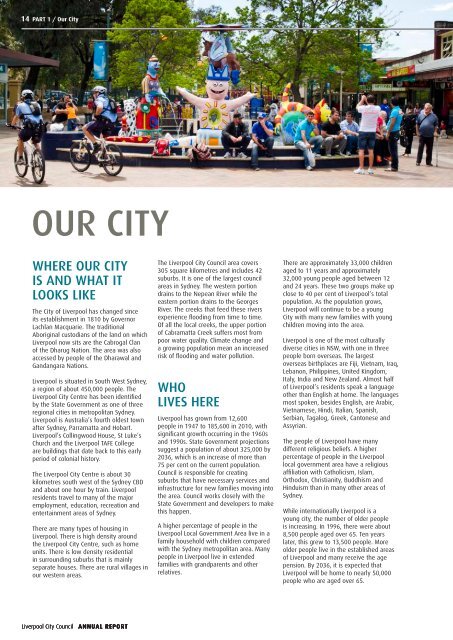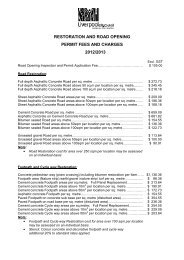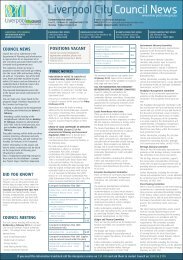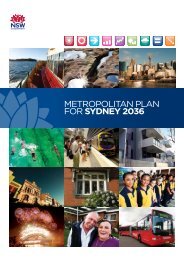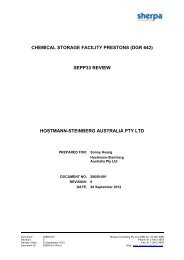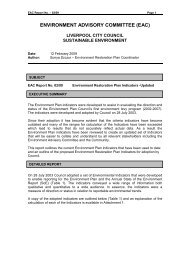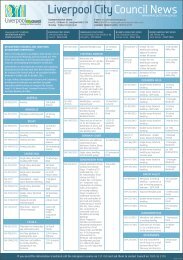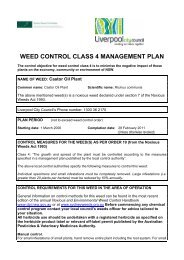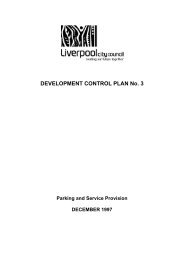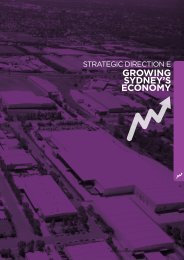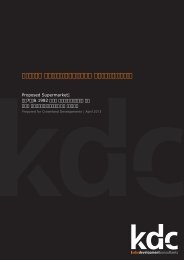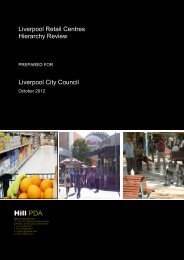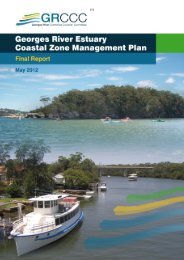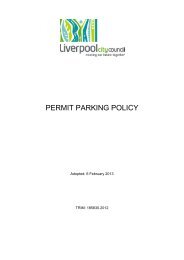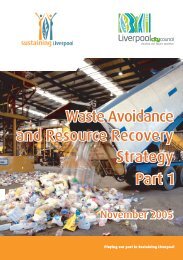State of the Environment Report 2010/2011 - Liverpool City Council
State of the Environment Report 2010/2011 - Liverpool City Council
State of the Environment Report 2010/2011 - Liverpool City Council
You also want an ePaper? Increase the reach of your titles
YUMPU automatically turns print PDFs into web optimized ePapers that Google loves.
14 PART 1 / Our <strong>City</strong><br />
OUR city<br />
Where our <strong>City</strong><br />
is and what it<br />
looks like<br />
The <strong>City</strong> <strong>of</strong> <strong>Liverpool</strong> has changed since<br />
its establishment in 1810 by Governor<br />
Lachlan Macquarie. The traditional<br />
Aboriginal custodians <strong>of</strong> <strong>the</strong> land on which<br />
<strong>Liverpool</strong> now sits are <strong>the</strong> Cabrogal Clan<br />
<strong>of</strong> <strong>the</strong> Dharug Nation. The area was also<br />
accessed by people <strong>of</strong> <strong>the</strong> Dharawal and<br />
Gandangara Nations.<br />
<strong>Liverpool</strong> is situated in South West Sydney,<br />
a region <strong>of</strong> about 450,000 people. The<br />
<strong>Liverpool</strong> <strong>City</strong> Centre has been identified<br />
by <strong>the</strong> <strong>State</strong> Government as one <strong>of</strong> three<br />
regional cities in metropolitan Sydney.<br />
<strong>Liverpool</strong> is Australia’s fourth oldest town<br />
after Sydney, Parramatta and Hobart.<br />
<strong>Liverpool</strong>’s Collingwood House, St Luke’s<br />
Church and <strong>the</strong> <strong>Liverpool</strong> TAFE College<br />
are buildings that date back to this early<br />
period <strong>of</strong> colonial history.<br />
The <strong>Liverpool</strong> <strong>City</strong> Centre is about 30<br />
kilometres south west <strong>of</strong> <strong>the</strong> Sydney CBD<br />
and about one hour by train. <strong>Liverpool</strong><br />
residents travel to many <strong>of</strong> <strong>the</strong> major<br />
employment, education, recreation and<br />
entertainment areas <strong>of</strong> Sydney.<br />
There are many types <strong>of</strong> housing in<br />
<strong>Liverpool</strong>. There is high density around<br />
<strong>the</strong> <strong>Liverpool</strong> <strong>City</strong> Centre, such as home<br />
units. There is low density residential<br />
in surrounding suburbs that is mainly<br />
separate houses. There are rural villages in<br />
our western areas.<br />
The <strong>Liverpool</strong> <strong>City</strong> <strong>Council</strong> area covers<br />
305 square kilometres and includes 42<br />
suburbs. It is one <strong>of</strong> <strong>the</strong> largest council<br />
areas in Sydney. The western portion<br />
drains to <strong>the</strong> Nepean River while <strong>the</strong><br />
eastern portion drains to <strong>the</strong> Georges<br />
River. The creeks that feed <strong>the</strong>se rivers<br />
experience flooding from time to time.<br />
Of all <strong>the</strong> local creeks, <strong>the</strong> upper portion<br />
<strong>of</strong> Cabramatta Creek suffers most from<br />
poor water quality. Climate change and<br />
a growing population mean an increased<br />
risk <strong>of</strong> flooding and water pollution.<br />
Who<br />
lives here<br />
<strong>Liverpool</strong> has grown from 12,600<br />
people in 1947 to 185,600 in <strong>2010</strong>, with<br />
significant growth occurring in <strong>the</strong> 1960s<br />
and 1990s. <strong>State</strong> Government projections<br />
suggest a population <strong>of</strong> about 325,000 by<br />
2036, which is an increase <strong>of</strong> more than<br />
75 per cent on <strong>the</strong> current population.<br />
<strong>Council</strong> is responsible for creating<br />
suburbs that have necessary services and<br />
infrastructure for new families moving into<br />
<strong>the</strong> area. <strong>Council</strong> works closely with <strong>the</strong><br />
<strong>State</strong> Government and developers to make<br />
this happen.<br />
A higher percentage <strong>of</strong> people in <strong>the</strong><br />
<strong>Liverpool</strong> Local Government Area live in a<br />
family household with children compared<br />
with <strong>the</strong> Sydney metropolitan area. Many<br />
people in <strong>Liverpool</strong> live in extended<br />
families with grandparents and o<strong>the</strong>r<br />
relatives.<br />
There are approximately 33,000 children<br />
aged to 11 years and approximately<br />
32,000 young people aged between 12<br />
and 24 years. These two groups make up<br />
close to 40 per cent <strong>of</strong> <strong>Liverpool</strong>’s total<br />
population. As <strong>the</strong> population grows,<br />
<strong>Liverpool</strong> will continue to be a young<br />
<strong>City</strong> with many new families with young<br />
children moving into <strong>the</strong> area.<br />
<strong>Liverpool</strong> is one <strong>of</strong> <strong>the</strong> most culturally<br />
diverse cities in NSW, with one in three<br />
people born overseas. The largest<br />
overseas birthplaces are Fiji, Vietnam, Iraq,<br />
Lebanon, Philippines, United Kingdom,<br />
Italy, India and New Zealand. Almost half<br />
<strong>of</strong> <strong>Liverpool</strong>’s residents speak a language<br />
o<strong>the</strong>r than English at home. The languages<br />
most spoken, besides English, are Arabic,<br />
Vietnamese, Hindi, Italian, Spanish,<br />
Serbian, Tagalog, Greek, Cantonese and<br />
Assyrian.<br />
The people <strong>of</strong> <strong>Liverpool</strong> have many<br />
different religious beliefs. A higher<br />
percentage <strong>of</strong> people in <strong>the</strong> <strong>Liverpool</strong><br />
local government area have a religious<br />
affiliation with Catholicism, Islam,<br />
Orthodox, Christianity, Buddhism and<br />
Hinduism than in many o<strong>the</strong>r areas <strong>of</strong><br />
Sydney.<br />
While internationally <strong>Liverpool</strong> is a<br />
young city, <strong>the</strong> number <strong>of</strong> older people<br />
is increasing. In 1996, <strong>the</strong>re were about<br />
8,500 people aged over 65. Ten years<br />
later, this grew to 13,500 people. More<br />
older people live in <strong>the</strong> established areas<br />
<strong>of</strong> <strong>Liverpool</strong> and many receive <strong>the</strong> age<br />
pension. By 2036, it is expected that<br />
<strong>Liverpool</strong> will be home to nearly 50,000<br />
people who are aged over 65.<br />
<strong>Liverpool</strong> <strong>City</strong> <strong>Council</strong> ANNUAL REPORT


